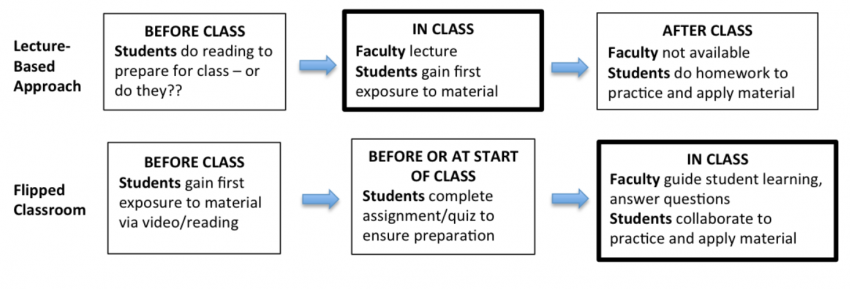In a flipped classroom, material typically explored in lecture is delivered outside of class through video lectures, lecture slides, digital modules, and/or other online media. In place of traditional lecture, class time focuses on the development of knowledge through active learning strategies like discussion, problem sets, case studies, group activities, or experiential learning. Research into the effectiveness of flipping a classroom continues to develop, with mixed results as to their greater effectiveness over traditional structures. A few studies suggest that flipping the classroom can improve students’ conceptual grasp of content beyond memorization and basic knowledge (Berrett 2012 and Casasola 2017). In their variable nature, flipped classrooms can also provide students with a greater mixture of activities, media, and opportunities to participate, thus serving more diverse populations and assuring more inclusive opportunities (Lage, 2000).
Instructors should be aware that studies also relate student resistance to the flipped classroom, observing that flipped activities require more rigorous work and thinking from students in class (Lieberman, 2017). Student culture at Yale traditionally expects lecture content, but certain strategies for flipping have proven effective, and students report satisfaction with strategies that clearly improve their learning experience (http://ctl.yale.edu/TeachingExcellence/KyleJensen).
Flipping also does not ease instructor preparation time; in many cases, instructors have more to prepare, between developing quality lecture videos or out-of-class content, while designing active in-class practices with efficient assessments to measure impact. Instructors can consider a variety of examples and strategies to evaluate the best modes of flipping in order to meet their desired learning outcomes.
Examples and Recommendations
Flipped Classes:
- Yale professor Kyle Jensen flips his economics class to enable more class discussion.
- Yale’s Anesthesiology department offers flipped course content through video resources and lists of resources.
- Harvard professor Peter Galison flips his course on the Einsteinian revolution by creating online lessons with interactive components.
- Michigan professor Steve Skerlos flips his mechanical engineering course with reflective questions and problem sets.
Methods:
In these and other courses, students experience ‘first exposure’ to content before class, rather than in class. The flipped model argues that this early exposure builds in time for students to consider and familiarize themselves with content before engaging with it more actively in class.

Figure 1: Flipped Classroom Philosophy, UMichigan CRLT
Vanderbilt’s CTL summarizes the four core actions that instructors can use to flip a classroom. Below are some examples of each principle. An instructor can provide:
- Textbook readings.
- Videos from YouTube, the Khan Academy, MIT’s OpenCourseWare, or Coursera
- Professionally recorded lectures
- PDFs with a walk-through of how to solve a problem
- Detailed Power Point slides
- Video recorded from a computer or smartphone, walking through how to solve a problem
- An incentive for students to prepare for class.
- Small group discussions
- In-class practice problem sets
- Group debates
- Group projects
- A mechanism to assess student understanding.
- Low-stakes formative assessment activities
- Peer-evaluation of writing or problem sets
- Self-evaluation assignments
- Pre-class worksheets
- Pre-class online quizzes
- In-class activities that focus on higher level cognitive activities.
- Conceptual questions
- Real-world application
- Data analysis and synthesis
More Classroom Activities:
- Instructors can consider other active learning exercises for classroom use like think-pair-share, jigsaw discussions, and idea mapping.
- Instructors can also peruse Open Access and Open Educational Resources for content to enhance a flipped environment.
Additional Resources
DeLozier, S., and Rhodes, M. (2017). Flipped Classrooms: a Review of Key Ideas and Recommendations for Practice. Educational Psychology Review 29: 141-151.
Flipping the Classroom, University of Washington Center for Teaching and Learning
Flipping the Classroom, Vanderbilt Center for Teaching
Flipping Your Class, University of Michigan Center for Research on Teaching and Learning
References
Berrett D (2012). How ‘flipping’ the classroom can improve the traditional lecture. The Chronicle of Higher Education, Feb. 19, 2012.
Casasola, T., Tutrang, N., Warschauer, M., and Schenke, K. (2017). Can Flipping the Classroom Work? Evidence From Undergraduate Chemistry. International Journal of Teaching & Learning in Higher Education 29.3: 421-435.
Lage MJ, Platt GJ, and Treglia M (2000). Inverting the classroom: A gateway to creating an inclusive learning environment. The Journal of Economic Education 31: 30-43.
Lieberman, M. Trial and Error: To Flip or Not to Flip? (2017). Inside Higher Ed. Inside Digital Learning, 1 November 2017.
